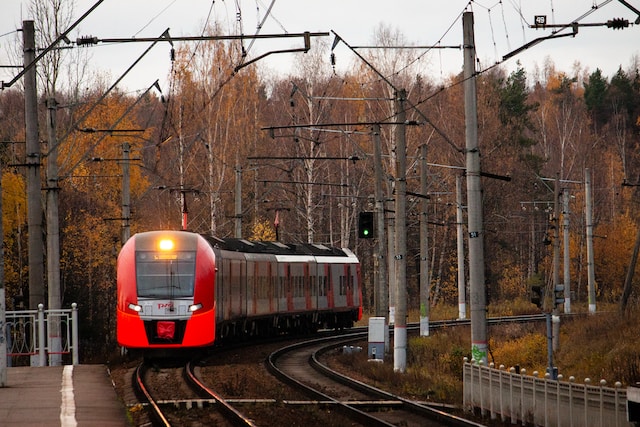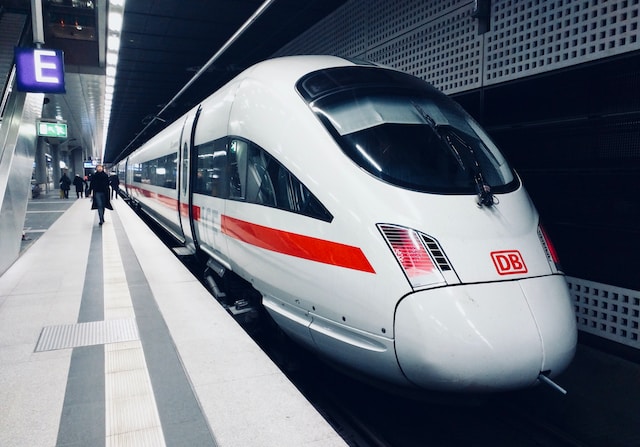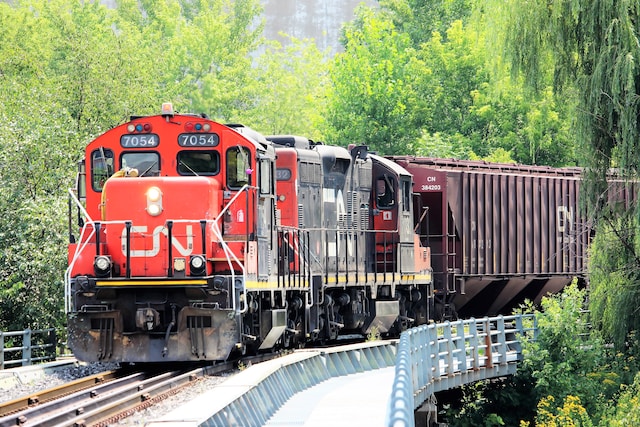
Trains are part of the future of transportation to conserve energy and be sustainable. Gone are the days of rickety old steam engines chugging their way across the landscape, belching black smoke and leaving a trail of destruction in their wake. Today’s trains are sleek, efficient, and remarkably environmentally friendly.
They’re part of a movement towards a brighter, more sustainable future, a future in which we take care of our planet and use its resources in a responsible, respectful way.
But it’s not just the eco-friendly aspect that makes railways so remarkable. There’s something hypnotic about the rhythm of the tracks, the gentle swaying of the carriage as you speed through the countryside. It’s a journey that’s as much about the experience as it is about the destination – a chance to sit back, relax, and enjoy the ride.
And the possibilities are endless. Imagine a world where we could travel from coast to coast without ever taking to the skies, simply by hopping aboard a high-speed train. With a network of interconnected rails stretching across the globe, the world would truly be our oyster.
Advantages of Trains as Renewable Transportation
Trains, powered by renewable energy sources, offer a multitude of advantages that make them a sustainable and efficient mode of transportation. These benefits extend to both passengers and cargo transport, making trains a key player in the quest for greener and more sustainable transportation systems.
Energy Efficiency
Railways are renowned for their energy efficiency, making them one of the most sustainable options for transportation. They are significantly more energy-efficient than other transportation modes, such as cars or airplanes. The energy required to move a train is spread across multiple carriages, reducing energy consumption per passenger or ton of cargo.
Reduced Greenhouse Gas Emissions

One of the most significant advantages of using railways as renewable transportation is the reduction in greenhouse gas emissions. Trains produce fewer greenhouse gas emissions per passenger-kilometer or ton-kilometer compared to most other forms of transportation. By using renewable energy sources, such as electricity generated from wind, solar, or hydropower, the carbon footprint of train travel can be greatly reduced, contributing to a cleaner environment.
Cost-Effectiveness
Railways offer economic advantages that are often overlooked in discussions of sustainable transportation.
- Operational Efficiency: Trains are highly efficient in moving large numbers of passengers or goods at lower operating costs compared to other modes.
- Reduced Fuel Costs: Trains can be powered by electricity or renewable fuels, offering more stable and cost-effective energy sources compared to fluctuating oil prices.
- Infrastructure Longevity: Train tracks and infrastructure have a long lifespan, requiring less frequent replacement and maintenance compared to roads and runways.
Trains are known for their substantial passenger and cargo capacity, providing a sustainable solution to the challenge of moving people and goods efficiently.
The Role of Trains in Moving People and Goods
- Mass Transit: Railways offer a high passenger capacity, making them ideal for urban mass transit systems, reducing traffic congestion, and easing the burden on road networks.
- Freight Transportation: Trains are a key player in moving goods over long distances efficiently, reducing the number of trucks on highways and minimizing wear and tear on roads.
The advantages of trains as renewable transportation extend beyond sustainability to encompass cost savings, energy efficiency, and the capacity to transport large volumes of people and cargo. As the world strives to reduce its carbon footprint and create more sustainable transportation systems, trains are increasingly recognized for their role in achieving these goals.
Renewable Energy Sources for Trains
Railways powered by renewable energy sources are at the forefront of sustainable transportation solutions. The adoption of renewable energy technologies in train systems not only reduces environmental impacts but also paves the way for more efficient and eco-friendly mass transit.
Electrification
Electric trains are a longstanding and proven approach to renewable train transportation, with overhead lines and third rails as common methods of electrification.

Overhead Lines
Overhead lines supply trains with electricity via catenary wires. Trains equipped with pantographs can draw power from these wires while in motion. This technology has been in use for decades, and it remains a reliable and efficient means of electrification.
Electric trains are highly efficient, delivering power directly to the wheels with minimal energy loss. Electricity can be generated from renewable sources, reducing greenhouse gas emissions. Electric trains are quieter than diesel or gas-powered counterparts, contributing to a quieter and more pleasant urban environment.
Hydrogen Fuel Cells
Hydrogen-powered trains are emerging as a promising and environmentally friendly option for rail transportation. Hydrogen fuel cells convert hydrogen gas into electricity, providing a clean and efficient power source for trains. These trains emit only water vapor as a byproduct and have the potential to revolutionize rail travel.
Battery-Electric Trains
Battery-electric trains are gaining momentum, thanks to advancements in battery technology and the transition to cleaner energy sources. Modern lithium-ion batteries are being utilized to store and deliver electric power to trains.

These batteries can be recharged while the train is at stations, reducing the reliance on overhead wires or third rails.
Solar-Powered Trains
Solar panels are increasingly being integrated into train systems to harness solar energy for auxiliary systems and reduce the energy load. Solar panels are installed on train roofs to generate electricity that can be used for lighting, climate control, and auxiliary systems. While not the primary power source, solar energy contributes to overall energy efficiency and sustainability.
Adopting these renewable energy sources for railways not only helps reduce the environmental impact of rail transportation but also promotes the use of clean energy in the wider transportation sector. The continued development and integration of renewable technologies hold the potential to revolutionize train travel and further reduce the carbon footprint of this sustainable mode of transportation.
Challenges and Considerations
While railways powered by renewable energy sources hold great promise for sustainable transportation in the race against climate change, several challenges and considerations must be addressed to maximize their potential. These issues encompass infrastructure, energy storage, and integration with other modes of transportation.
Infrastructure Upgrades
Transitioning to renewable train transportation often requires significant infrastructure changes, which come with their own set of challenges. Electrifying train lines can be expensive, especially in regions with extensive rail networks. Overcoming these costs and securing funding for infrastructure upgrades can be a substantial hurdle.
Energy Storage and Distribution
Efficient energy storage and distribution systems are critical for the success of renewable railways. Electric and hydrogen-powered trains rely on effective energy storage systems. Advances in energy storage technologies are necessary to ensure consistent and reliable power supply to trains.
Integration with Other Modes of Transportation
Seamless integration between trains and other modes of transportation is essential for promoting a comprehensive and efficient transportation network. Connecting train stations with buses, trams, and urban transit networks is vital for creating a multi-modal transportation system. Coordination between different modes of transportation, schedules, and ticketing systems can be complex but is crucial for passenger convenience and efficient travel.
Addressing these challenges and considerations is integral to making renewable trains a more viable and practical transportation solution. By investing in infrastructure upgrades, enhancing energy storage capabilities, and promoting integration with other modes of transportation, the full potential of renewable trains can be realized. These efforts will not only reduce the environmental impact of transportation but also improve the overall efficiency and sustainability of rail travel.
Future Prospects and Innovations

The future of trains as renewable transportation holds exciting possibilities, with ongoing innovations and sustainability initiatives that are poised to transform the landscape of rail travel.
High-Speed Renewable Trains
High-speed trains are a major focus of innovation. Advances in aerodynamics, propulsion systems, and materials are driving the development of even faster and more energy-efficient high-speed trains. High-speed rail networks are expanding worldwide, providing eco-friendly alternatives to domestic flights and reducing the carbon footprint of long-distance travel.
Sustainability Initiatives
Rail agencies and operators continue to prioritize sustainability, aiming to reduce energy consumption, emissions, and environmental impacts. These efforts include adopting cleaner energy sources and more efficient technologies.
Global Expansion
The adoption of renewable energy sources for trains is not limited to a few regions. A global expansion of sustainable rail travel is anticipated, with countries worldwide exploring the potential of renewable trains in their transportation systems.
Ambitious projects are underway to connect continents via high-speed rail, making international train travel more accessible, efficient, and eco-friendly.
The future prospects for trains powered by renewable energy are exciting, with innovations such as high-speed rail advancements, continued sustainability initiatives, and the potential for global expansion. As these innovations become a reality, renewable trains are expected to play a key role in reducing the environmental impact of transportation while providing efficient and sustainable travel options for people around the world.


